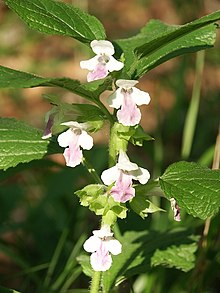| Bastard balm | |
|---|---|

| |
|
Scientific classification
| |
| Kingdom: | Plantae |
| Clade: | Tracheophytes |
| Clade: | Angiosperms |
| Clade: | Eudicots |
| Clade: | Asterids |
| Order: | Lamiales |
| Family: | Lamiaceae |
| Subfamily: | Lamioideae |
| Genus: |
Melittis L. |
| Species: | M. melissophyllum
|
| Binomial name | |
| Melittis melissophyllum | |
| Synonyms [1] | |
| |
Melittis melissophyllum is a species of flowering plant in the mint family, Lamiaceae. Its common name is bastard balm. It is the only species in the monotypic genus Melittis. [2] The genus name is derived from the Greek melitta, which is in turn from melissa ("a bee"). [3]
- Subspecies [1]
- Melittis melissophyllum subsp. albida (Guss.) P.W.Ball - eastern Mediterranean from Sardinia to Turkey
- Melittis melissophyllum subsp. carpatica (Klokov) P.W.Ball - eastern Europe from Austria to Baltic States
- Melittis melissophyllum subsp. melissophyllum - western Europe from Britain to Spain + Italy
Distribution
It is native to central and southern Europe from the British Isles + Portugal east to Turkey + Ukraine + Baltic States. [1] [4]
Description
Melittis melissophyllum reaches on average 30–50 centimetres (12–20 in) of height, with a minimum of 20 centimetres (7.9 in) and a maximum of 60 centimetres (24 in). It is a strongly aromatic plant with erect hairy stems. The root of this plant is a perennial short rhizome. This species is quite variable in shape of leaves and colors. The leaves reach 5–9 centimetres (2.0–3.5 in) of length. They are oval, bluntly-toothed, quite hairy. They have a short petiole and are in opposite pairs up the stems. The inflorescence is composed of large pedunculated hermaphrodite flowers (two to six, or more) growing in the axils of the leaves. The flowers are labiate, arranged in pairs and are one-sided (all flowers "look" at the same side). They are usually white or pale pink with a large pinkish purple blotch on the lower lip. They are mainly pollinated by bees and moths. The flowering period extends from May through August.
Habitat
The plant grows in shady deciduous woods, often with oak, beech, and chestnut. It can also be found among pines and junipers. It is common at altitudes of 0–1,400 metres (0–4,593 ft) above sea level.
Cultivation
Bastard balm grows well as an edging in a sunny woodland or a scrubby border. It is attractive to insects. Cultivars include 'Royal Velvet Distinction'.
Gallery
-
Form
-
Flowers
-
In white
-
'Royal Velvet Distinction'
-
Leaf
Notes
- ^ a b c Kew World Checklist of Selected Plant Families
- ^ Scheen, A. C., et al. (2008). Molecular phylogenetics of tribe Synandreae, a North American lineage of lamioid mints (Lamiaceae). Cladistics 24(3) 299-314.
- ^ Nicholson, G., et al. The Illustrated Dictionary of Gardening: Volume 4. L. Upcott Gill. 1887. pg. 347.
- ^ Altervista Flora Italiana, Erba limona, Bastard Balm, Melittis melissophyllum L. includes photos + European distribution map
References
- Pignatti S. - Flora d'Italia - Edagricole – 1982 Vol. II, pg. 452
- Pink, A. - Gardening for the Million (2004) - Project Gutenberg|Project Gutenberg Literary Archive Foundation| ISBN 1-4264-5707-3 Gardening for the Million
- Klein Carol - How to grow Melittis melissophyllum - The Daily Telegraph - How to grow
- Canadian Food Inspection Agency: Plant Breeders' Rights Office: "Royal Velvet Distinction" - 30 Apr 2007 - Melittis melissophyllum
External links
- Biolib
- Melittis melissophyllum
- Bastard Balm
- Plants
-
 Media related to
Melittis melissophylum at Wikimedia Commons
Media related to
Melittis melissophylum at Wikimedia Commons




